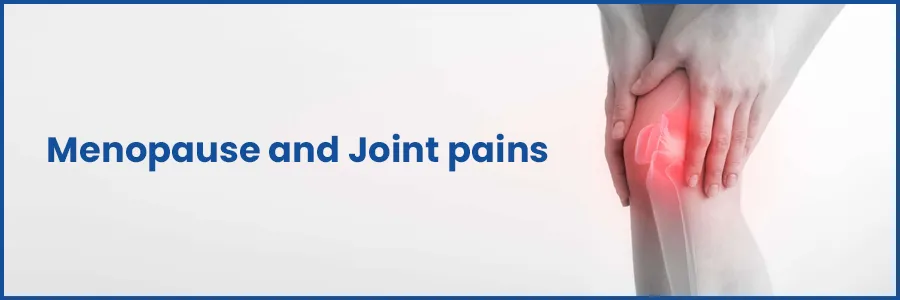
Menopause and Joint pains: All You Need to Know
Menopause is a natural phase in every women life that signifies the end of her reproductive years. While it can be a liberating transition, menopause also brings about various physical and hormonal changes. Among the common challenges women face during this time is joint pain. So, we will explore the connection between menopause and joint pains, shed light on the causes, and offer effective strategies for managing and easing discomfort during this transformative phase
About Menopause:
It is a normal biological process that occurs in women in between the ages of 45 and 55. It is officially defined as the absence of menstrual periods for 12 consecutive months. During menopause, the production of estrogen and progesterone, two essential hormones for female reproductive health, decreases significantly.
Connection between Joint pains & Menopause:
As women approach and experience menopause, hormonal fluctuations can impact various systems in the body, including the musculoskeletal system. Estrogen plays a crucial role in maintaining joint health, as it helps reduce inflammation and contributes to joint lubrication. Therefore, the decline in estrogen levels during menopause can lead to joint-related issues, such as stiffness, swelling, and pain.
Common Joint Pains during Menopause:
- Osteoarthritis: Menopause can exacerbate osteoarthritis, a degenerative joint disease that causes the breakdown of cartilage and leads to joint pain and stiffness.
- Rheumatoid Arthritis: Some women may experience the onset of rheumatoid arthritis during menopause, an autoimmune disorder that causes joint inflammation and pain.
- Carpal Tunnel Syndrome:Menopause-related hormonal changes may contribute to swelling in the wrists, leading to compression of the median nerve and causing carpal tunnel syndrome.
- General Joint Discomfort:Many women report generalized joint discomfort during menopause, which may affect various joints in the body.
Secure your health with a second opinion. Make informed decisions and book your appointment today!
Get A Second OpinionTips to Manage Joint Pains during Menopause:
Robotic surgery is utilized across various medical specialties, including:
- Stay Active:Engage in regular low-impact exercises, such as walking, swimming, or yoga, to keep joints flexible and strengthen surrounding muscles.
- Maintain a Healthy Weight:Excess weight puts additional stress on joints. Adopting a balanced diet and staying physically active can help manage joint pain.
- Hot and Cold Therapy: Applying heat pads or warm compresses can alleviate joint stiffness, while cold packs can help reduce inflammation and swelling
- Ergonomic Considerations: Be mindful of your posture and body mechanics during daily activities to reduce strain on joints. Use ergonomic tools and accessories if necessary.
- Consider Supplements: Consult with your healthcare provider about adding supplements like calcium, vitamin D, and omega-3 fatty acids to support joint health.
- Mind-Body Techniques:Practices like meditation and deep breathing can help manage stress, which can indirectly impact joint pains.
Seeking Professional Help:
If joint pains significantly affect your daily life or if you suspect an underlying joint condition, seek medical advice. A healthcare professional can conduct a thorough evaluation, provide an accurate diagnosis, and recommend appropriate treatment options.
The Importance of Self-Care and Emotional Well-being:
Menopause is not only a physical transition but an emotional one as well. Take time to prioritize self-care and emotional well-being. Connect with friends and loved ones, join support groups, and share experiences to find comfort and understanding during this stage of life.
Conclusion
Menopause is a natural and transformative journey that brings about various changes, including joint pains. While this discomfort can be challenging, understanding the connection between menopause and joint health empowers women to take proactive steps toward managing and alleviating these symptoms. By adopting a holistic approach that includes regular exercise, a balanced diet, self-care, and seeking professional help when needed, women can navigate through menopause with grace and embrace the new chapter of their lives with confidence and vitality.
Ready to take control of your health journey? Book your appointment now and start your path towards wellness today!
Book an AppointmentFrequently Asked Questions
Yes, joint pain is a common symptom experienced by many women during menopause. The hormonal changes, especially the decline of estrogen, can affect joint health and lead to discomfort and stiffness.
Menopause-related joint pain can affect various joints, but the weight-bearing joints such as knees and hips are often the most commonly affected.
The primary cause of joint pain during menopause is the reduction of estrogen levels. Estrogen plays a role in maintaining joint health by reducing inflammation and supporting joint lubrication.
Yes, menopausal joint pain can be a sign of arthritis. Osteoarthritis and rheumatoid arthritis are two common forms of arthritis that may worsen during menopause.
Menopausal joint pain can vary in duration and intensity for each individual. Some women experience relief once hormonal levels stabilize, while others may continue to experience joint discomfort.
For some women, menopause-related joint pain may improve with time as the body adjusts to hormonal changes. However, lifestyle modifications and proper management can significantly contribute to reducing joint discomfort.
Effective management strategies include regular low-impact exercise, maintaining a healthy weight, using heat or cold therapy, incorporating joint-friendly supplements, and practicing stress-reducing techniques.
Low-impact exercises such as walking, swimming, tai chi, and yoga are particularly beneficial for improving joint flexibility and reducing pain during menopause.
Over-the-counter pain relievers like ibuprofen or acetaminophen can provide temporary relief for mild joint pains. However, it's essential to use them as directed and consult a healthcare provider if pain persists.
If joint pains significantly impact your daily activities, worsen over time, or are accompanied by other concerning symptoms, it's essential to consult a healthcare provider for a proper evaluation and diagnosis.
Hormone replacement therapy (HRT) may help alleviate some menopausal symptoms, including joint pain, for some women. However, the decision to undergo HRT should be made in consultation with a healthcare provider, considering individual health factors and risks.
A balanced diet rich in antioxidants, omega-3 fatty acids, and calcium can support joint health during menopause. Reducing inflammatory foods and staying hydrated may also be beneficial.
